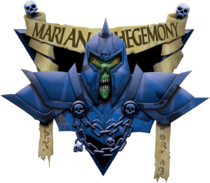Marian Hegemony
This article needs to be updated with material from Shattered Fortress. Once these titles clear the Moratorium period, or if they already have, please consider revisiting this article and updating it with the new material. |
| Marian Hegemony | |
|---|---|
| State Profile | |
| Founding Year | 2920 |
| Capital world: | Alphard |
| Controlled system(s): | approx. 23 |
| Official Currency | Talent |
| Official Language(s) | English and Latin (official), German, Spanish, Greek |
| Government | |
| Head of State | Caesar of the Marian Hegemony (formerly Imperator) |
| Military | |
| Army | Marian Hegemony Armed Forces (MHAF) |
| Military Intelligence | Ordo Vigilis |
The Marian Hegemony is a major Periphery state rimward and anti-spinward of Terra, beyond the Duchy of Tamarind-Abbey and Rim Commonality. The monarchist republican nation bears resemblance to the ancient Roman Empire with its national symbol being the bust of an armored Roman warrior against a tan banner that bears the name "Marian Hegemony" in English at its center and the Latin words "Pax" (Peace) and "Mortis" (of Death) on its opposite ends.
Contents
History[edit]
The origins of the Marian Hegemony lie from the demise of the old Alphard Trading Corporation during the Succession Wars. A Periphery native and lostech prospector named Johann Sebastian O'Reilly was searching for reputed lost caches of Star League technology on the planet Alphard, rumored to have been left behind by the defunct company, when he instead found a treasure trove of germanium worth billions upon billions of C-bills.[1]
Johann O'Reilly immediately hired some small mercenary units to protect his newly found wealth and established a colony to serve both as a trading hub and a distraction, diverting those who would follow him to the location of his find. Despite the financial reserves Johann could draw on, his new Hegemony was simply too small, unable to attract the defenders it would need to defend itself against larger states but too small to attract the attention of those states. As such, the Hegemony spent almost a century as little more than a bandit kingdom fashioned after a society that had been dead for millennia.[1]
Gaius O'Reilly, the son of Johann, left little impression on the history of the Marian Hegemony; by the 3060s, he was primarily remembered for two things: being the father of Marius O'Reilly, and for dying an ignominious death in 3009 when his horse stumbled into a chuckhole, causing Gaius to break his neck.[2]
The arrival of the Fourth Succession War and the resulting changes within the Inner Sphere brought the fledgling Marian Hegemony new possibilities. With most of the various pirate bands concentrating on the Inner Sphere, the new Imperator, Marius O'Reilly, saw a good opportunity to expand his young nation. The Hegemony had spent a century preying upon nearby trade routes and worlds as a means of keeping the economy functioning, but the advent of the Fourth Succession War, and other, more localized conflicts, gave rise to opportunities for much more successful and ambitious raids.[3]
The Imperator proved to be popular with his citizens, and was widely considered to be a good ruler for the Hegemony; Marius' only major misstep was prompted by a failed assassination attempt against him, an assassination attempt that led to him ordering an ill-advised and unsuccessful invasion of the world of Astrokaszy.[3]
Marius continued to expand the Hegemony through colonization efforts, marking a peaceful era for the Marian Hegemony, but one that also led to Marius' downfall. Marius O'Reilly died on a Marian colony world named Herculaneum in 3048; with his father's death officially declared to be the result of a "climbing accident," Sean O'Reilly became the new Imperator. The mourning period for Marius would be marked by intense speculation in the Hegemony that Sean had in fact been responsible for the death of his father.[3]
When Sean emerged from the official mourning period, he abandoned the title of Imperator; instead, he proclaimed that he would rule as Caesar. Sean then promptly began a radical restructuring of the Marian state and government; no longer modelled after the ancient Roman Republic, Sean's intent was to instead model the Hegemony after the ancient Roman Empire. Sean dealt with those protesting against his increasingly dictatorial regime in one of two ways; either his critics and detractors were silenced through promises of great wealth, or they were silenced by the application of great force.[3] Sean also introduced conscription, ordering that all able-bodied males be conscripted into military service either at the age of seventeen or on completion of any higher education; while he exempted women from enforced conscription, women were allowed to join the military voluntarily.[4]
Having secured his hold over the population, Sean embarked on an expansion of the Hegemony through conquest. To this effect, in 3054 he invaded the Lothian League,[3] a small nation of just seven planets founded by refugees from the Taurian Concordat in the aftermath of the Reunification War centuries before. In 3057, Sean O'Reilly invaded the world of Astrokaszy; he hoped to capture the planet with assistance from the Blakist faction known as the Sixth of June and then use the planet as a staging ground for later invasions.[5]
His son Julius, a recent graduate of the Collegium Bellorum Imperium, had been recently promoted to command a century in the First Legion. He quickly gained the attention of several powerful military leaders and Senators as well as attracting the notice of those working against Sean. Sean responded to Julius' rise by posting him out of the First Legion, promoting him to command the second cohort of the Second Legion. Julius' transfer and promotion were an effort to secure his own safety, but proved to be a significant mistake on Sean's part; the Second was based on the Lothian world of Lordinax, and Julius' arrival in June 3060 marked a turning point in his rise.[6]
When Julius arrived, the Second Legion was suffering repeated attacks from rebel forces and was rapidly becoming demoralized. Sean's first orders were for Julius to be sent on punitive raids against a number of Lothian settlements believed to be harboring rebels, a campaign that Sean hoped would either see Julius killed or toughened up; instead, it led Julius to begin openly questioning the occupation of the League and his father's decisions.[6]
Julius began to covertly build a power base within the Legion, promising an end to the Lothian troubles. Within a year of landing on Lordinax, Julius had ended the resistance and was ready to make his next move.[7]
The conquest of the Palatinate lasted only a short while, as the small nation was only defended by two mercenary units, the Arms of Thor and Cavanaugh's Cavalry. The invasion was initially stopped by the determined and spirited defense offered by the Arms, and the Legions took heavy damage - but Julius was able to strike a deal with Cavanaugh's Commandos in which they would stand down in exchange for a payment and a place in the Hegemony Armed Forces. He left the Palatinate under the control of local citizens, and under the watchful guard of elements of the Third Legion and a full auxiliary legion, returning to Alphard as the conquering hero who had added new worlds to the Hegemony and ended the Lothian rebellion.[7]
Julius returned to the capital at the head of the Second and Fourth Legions, where he was hailed as a great hero and conqueror by the citizens of the Hegemony. In a dramatic speech to his people, Julius declared his father unfit to rule the Hegemony, and declared himself the new leader of the nation. The Senate confirmed his appointment by acclamation.[8]
However, Sean O'Reilly still lived, having holed up in his Palace with the entirety of the First Legion. He refuted his son's claim to the throne and instructed the First to put down his son's rebellion. Less than half of the First obeyed Sean's orders, only to fall quickly beneath the advancing Second Legion on the 8th of August 3063; Julius confronted Sean in the throne room and offered him one final chance to abdicate in the face of his many misdeeds over the years, only for Sean to make one last attempt on Julius' life. Julius cut his father down personally.[8]
Julius was inaugurated the following day, and began his reign by ordering the implementation of a number of reforms, both social and military. The new Caesar's reforms didn't stop there; intent on making Marian society more "Roman", Julius created a new body, the Plebian Tribunate; while the plebs were still denied the right to vote on any subject other than the selection of planetary Tribunes, the Plebian Tribunate gave the plebs a voice of their own in the government.[8]
Under Julius' rule, the Hegemony grip on the worlds of the former Illyrian Palatinate and Lothian League tightened, but Julius also established some freedoms for the inhabitants of those worlds that they hadn't possessed during their independent rule.[9]
Despite the reforms initiated by Julius and his focus on building both unity and goodwill within the Hegemony, Julius didn't give up his ambitions to expand the Hegemony by conquest as well. As Caesar, Julius intended to invade and annex the nearby Circinus Federation, with the groundwork for his invasion beginning to be laid in 3063.[9] The war was a victory for the Marian Hegemony, although it achieved less than Julius had hoped.[10][11]
In early 3069 the Marian Hegemony found itself facing potential revolt in the conquered Illyrian and Lothian provinces as both passive and active rebellions began spreading through both regions in a wave.[12]
During the Word of Blake Jihad, the Marian Hegemony fought the Blakists' proxies, the Circinus Federation, in a bloody conflict that saw the small Periphery holding vanquished and partially occupied by the victorious Marian troops. The Marian Hegemony also at some time gave the Lothian League back its freedom (as shown on maps dating from the 3120s), although the reasons are as yet unclear.
It was reported in the media on Alphard in September 3077 that couriers from the Circinus Federation border of the Hegemony were bringing news that a Marian offensive against the Federation had died effectively stillborn, with probing attacks on the planets of Thadora's Land and Zorn's Keep being rebuffed by significantly stronger Federation forces.[13]
In the period immediately after the Jihad, the Marian Hegemony Armed Forces faced a period of rebuilding their strength after the damage inflicted during the attempted annexation of several Free Worlds League planets - the exception being V Legio, which had been struck from the rolls of the MHAF after defecting to become the principal military force of the new Lothian state.[14] While intelligence agencies hadn't confirmed the fact, Caesar Cassius O'Reilly had ordered that the Hegemony's military production should expand, to prevent a single deliberate attack destroying the bulk of the realm's industrial base, as had nearly happened once already.[15]
In 3147, Hegemony forces invaded the Free Worlds League, taking worlds among few. However Duchy of Tamarind-Abbey lead by Duke Fontaine Marik would wage war repulse Marian forces from newly gained worlds. However, the new Free Worlds League government would prevent the renegade Duke from completing ejecting Hegemony forces, isolating the remaining forces on worlds Gibraltar, Atzenburgg, and Lepaterique area nicknamed "Gibraltar Island". It would not be until 3151 where privately funded mercenaries would hunt down the remaining Hegemony forces.[16]
Era Specific Data[edit]
2930
- Ruler: Imperator Johann O'Reilly
- Total (Inhabited) Systems: 9[17]
3025
- Ruler: Imperator Marius O'Reilly
- Total (Inhabited) Systems: 12
3055
- Ruler: Caesar Sean O'Reilly
- Total (Inhabited) Systems: 19
3063
- Total (Inhabited) Systems: 23
3067
- Ruler: Caesar Julius O'Reilly
- Total (Inhabited) Systems: 25
3130
- Ruler: Caesar Ignatius O'Reilly[18]
- Total (Inhabited) Systems: 22
- Estimated Population (3130): 28,605,000,000
- Unit of Currency: Talent (1 talent = 0.22 C-bills) (3130)
Political and Social Structure[edit]
The Marian Hegemony is an absolute monarchy, with absolute power vested in the Caesar, who can enforce his will by decree. The Hegemony also has a Senate, composed of patricians from every world of the nation (although the number of Senators sent varies by population). The Senate itself acts as a debate forum that rubber-stamps the Caesar's decrees, although the support of its members is one of the factors that let Julius become Caesar. Initially, the Senate was restricted to only full Hegemony Worlds, but Caesar Julius granted the worlds of the Lothian League and Illyrian Palatinate full status and gave them Senators.
The Hegemony itself is divided into three classes of people: the patricians, the plebeians, and the various slaves. The patricians are the self-perpetuating nobility of the Hegemony. Only they can serve in the Senate of the Hegemony, and they also make up the upper command structure of the Legions.
Directly below them are the plebs, who serve as the middle and lower-class of the Hegemony. They have little political power, and rarely advance in the ranks of the bureaucracy or the military. Before Caesar Julius' reforms, they had no voice in their leaders' selection, but Julius allowed them to vote for Planetary Tribunes (Governors) and for a special People's Tribune to be sent to the Senate.
The Hegemony is one of the largest Periphery nation to practice slavery, and openly condones it. Most slaves are prisoners of war, however, as it is forbidden to buy or sell a citizen of the Hegemony.
Dominant religions include Christianity (Lutheran), Judaism, Islam, and Agnosticism.
Manufacturing Centers[edit]
A detailed list of some Marian Hegemony manufacturers centers.
Major Defense Industries[edit]
3067[edit]
Foreign Relations[edit]
Inner Sphere: The Free Worlds League and the Capellan Confederation are the only two Successor States that have any formal relations with the Marian Hegemony. In the past, Marian raids on Free Worlds League border planets kept relations between them chilly. The recent Taurian-Canopian alliance, however, has prompted Thomas Marik toward friendlier ties with the Hegemony as a possible counter to aggressive moves by the Magistracy of Canopus. Trade between the two states remains as healthy as it has always been; Marik merchants eagerly buy germanium from the Hegemony, and sell any number of League-made goods to Hegemony customers. It is frequently said in the Hegemony that Marik merchants own the bazaars on the world of Suetonius. Following Thomas Marik's lead, the Capellan Confederation has also strengthened its ties to the Marian state.
Periphery: The Hegemony has almost no good relations with the other Periphery nations. Relations with the Magistracy of Canopus remain strained, due to a long history of raiding and looting brought on by Marian pirates. The Hegemony's war against the Lothian League angered the Protector of the Taurian Concordat, who then allied himself with the Magestrix against any potential Marian aggression.
The only Periphery nation to have any good relations with the Hegemony was the Circinus Federation, primarily due to their former mutual dislike of the Illyrian Palatinate. Although they had tried for a joint alliance to divide the Palatinate, that deal fell through, and relations became strained as a result.
Historical: Maps Gallery[edit]
References[edit]
- ↑ 1.0 1.1 Field Manual: Periphery, p. 69: "Nova Roma"
- ↑ Handbook: Major Periphery States, p. 154: "Spotlight: The Caesar"
- ↑ 3.0 3.1 3.2 3.3 3.4 Field Manual: Periphery, p. 70: "Nova Roma"
- ↑ Field Manual: Periphery, p. 75: "Ars Militaria"
- ↑ Field Manual: Periphery, p. 70: "Empire Building"
- ↑ 6.0 6.1 Field Manual: Periphery, p. 71: "Empire Building"
- ↑ 7.0 7.1 Field Manual: Periphery, p. 71: "Peace Through Superior Firepower"
- ↑ 8.0 8.1 8.2 Field Manual: Periphery, p. 72: "Crowning Achievement"
- ↑ 9.0 9.1 Field Manual: Updates, pp. 194–195: "Historical: Brief"
- ↑ Field Manual: Updates, p. 195: "The Marian Legions"
- ↑ Field Manual: Updates, p. 197: "The Caesar's War"
- ↑ Jihad: Final Reckoning, p. 46: "The Jihad in Review"
- ↑ Jihad Hot Spots: Terra, p. 53: "Federation Build-Up"
- ↑ Jihad: Final Reckoning, p. 116: "Marian Hegemony"
- ↑ Jihad: Final Reckoning, p. 117: "Marian Hegemony"
- ↑ Empire Alone, pp. 18+19: "Alone on a Island & We Will Fight Them on the Beaches"
- ↑ Handbook: Major Periphery States, p. 163: "Marian Hegemony at various stages"
- ↑ Touring the Stars, p. 93: "Marian Hegemony" 3130 Fact Sheet
- ↑ 19.0 19.1 19.2 Tactical Operations, p. 16: "Marian Hegemony"












